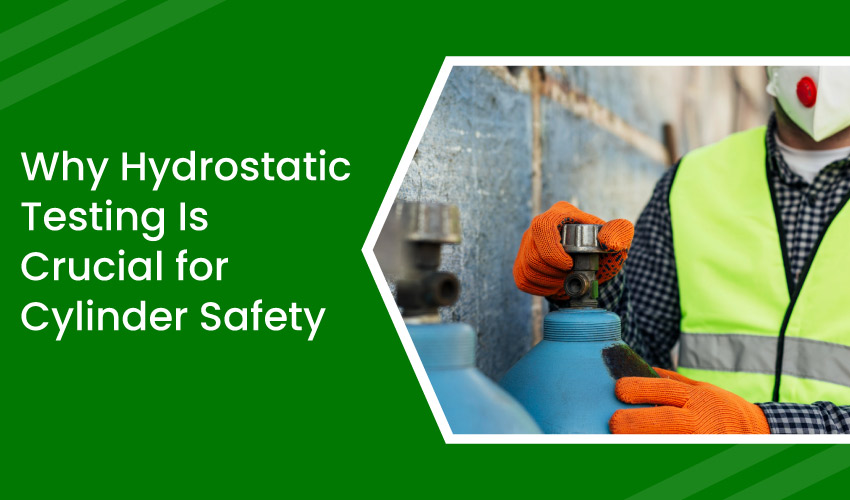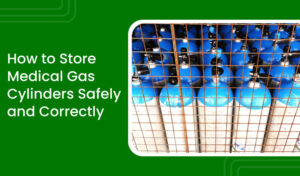
A cylinder containing hazardous gas requires undergoing some rigorous testing procedures to ensure the safe operation of the gas cylinders throughout their lifespan. Among various testing procedures a cylinder undergoes, hydrostatic testing stands out for testing the strength and leak-tightness. In this detailed blog post, we will explore why hydrostatic testing is crucial for cylinder safety, along with its benefits.
A] What Is Hydrostatic Testing?
Hydrostatic testing is a non-destructive test used to test the strength and leaks of high-pressure gas cylinders. It is performed by filling coloured liquid, usually water, into the cylinder and is pressurised up to 1.25 or 1.50 times the maximum allowable working pressure (MAWP). It is widely preferred over the air-based tests due to its proficiency in detecting strength and leaks and reduced chances of explosion.
Choose Rama Cylinders For Nationally and Internationally Quality-Qualified Cylinders
B] Why Is Hydrostatic Testing Essential for Cylinder Safety?
1. Identify Internal and External Structural Issues
Hydro testing is known for revealing those internal and external structural issues that may not be visible to the naked eye. It involves pressuring the vessel until its maximum working pressure. The maximum pressure exerted on the vessel’s wall reveals the material’s weakness and shows the hidden cracks, deformities, or wall thinning.
2. Eliminate Risk of Gas Leaks or Sudden Bursts
Hydrostatic testing pressurises the cylinders beyond their working pressure limits, which forces them to show the hidden deformities. If a cylinder fails the test, they are discontinued from further use. Doing so prevents failure while in use and eliminates the risk of gas leaks and sudden bursts and ensures the cylinder’s integrity under stress.
3. Meet Industry and Government Compliance Standards
The rules stated in the Gas Cylinders Rules, 2016, mandate periodic hydrostatic testing to ensure the safety and integrity of gas cylinders. Hydrostatic pressure testing of gas cylinders with specific frequency and procedures allows users to meet industry and government compliance standards. PESO (Petroleum and Explosives Safety Organisation) oversees the implementation of the rules outlined for gas cylinder safety.
4. Improve Cylinder Longevity and Maintenance Planning
Hydrostatic testing reveals the potential defects that may occur during operation. It helps reinforce the structural integrity of the cylinders for a longer period by proactively repairing and maintaining them.
5. Promote Workplace Safety and Operational Confidence
Prior detection of potential defects helps in proactive maintenance of cylinders. Hydrostatic testing allows potential defects to be repaired proactively and ensures workplace safety and operational confidence during use.
C] The Hydrostatic Testing Procedure Explained
The following are step-by-step procedures describing what happens during each stage of the hydrostatic testing procedure:
Step 1: Visual Inspection of the Cylinder
Initially, competent technicians first check for any visible damage, like corrosion, dents, and joints, to ensure the cylinder is strong enough to withstand the pressure exerted during hydrostatic testing. If found to be suspicious, they are rejected for testing and may be barred from services.
Step 2: Water Filling and Air Removal
In the second step, coloured water is filled slowly to reach the bottom of the cylinder and release trapped air. Trapped air can mask the potential leaks and influence the test accuracy if air pockets are not removed. Upon water filling, any visual water leakage is checked to assess the leakage in the first step.
Step 3: Applying Test Pressure
In this step, hydraulic pressure is exerted gradually to ensure the equal distribution of pressure throughout the cylinder. Every cylinder qualified for hydrostatic testing is pressurised up to 1.5 times its rated pressure to assess the durability and maximum pressure withstanding capacity.
Step 4: Monitoring for Expansion or Deformation
Monitoring for expansion or deformation is a crucial step of cylinder hydrostatic testing. It involves checking for yielding, cracking, expansion, or permanent deformation under pressure. If the mentioned deficiencies are found during pressurisation, it shows that the cylinder has failed the hydrostatic testing.
Step 5: Leak Detection and Pressure Drop Checks
At the end, the occurrence of leaks and pressure drops is observed at the maximum allowed pressure for testing. If the cylinder withstands the maximum pressure without any deformation or leaks, the cylinder is marked safe and robust for medical and industrial use.
D] Benefits of Regular Hydrostatic Testing
The hydrostatic testing offers ample practical and safety-related benefits. It includes cost-saving and overall risk reduction. It also helps in complying with rules and regulations issued by medical and industrial cylinder safety authorities. So, perform hydrostatic testing on every medical or industrial cylinder every 5 years or before the printed due date to ensure their structural integrity and mitigate the catastrophic events from occurring.
Choose Rama Cylinders For Nationally and Internationally Quality-Qualified Cylinders
Conclusion
The hydrostatic testing is highly efficient and a mandated testing procedure for medical as well as industrial gas cylinders containing high-pressure and hazardous gases. It tests for structural integrity and defects and ultimately mitigates unforeseen events from occurring.
Rama Cylinder is one of the largest CNG cylinder manufacturers in India. Each of our cylinders goes through rigorous tests, including hydrostatic testing, to qualify for the national and international quality demands. If you are looking for a trusted and globally recognised CNG, oxygen, nitrogen, nitrous oxide, or hydrogen gas cylinder manufacturer, contact us today!
FAQs
Hydrostatic testing for gas cylinders is a non-destructive test. It checks the cylinders for leaks and strength by filling the coloured water into the cylinder. The pressure is exerted up to 1.5 times the allowed working pressure to test the maximum pressure withstanding capacity.
Hydrostatic testing is vitally important for cylinder safety, as it assesses the strength required for safe operations. It also checks for leaks and mitigates the occurrence of catastrophic events in case of hazardous gas leaks.
Every gas cylinder should undergo hydrostatic testing every 5 years, depending upon the cylinder type, the gas it contains, and applicable regulations. Some gas cylinders, like hydrogen gas-containing cylinders, require more frequent hydro testing due to unique gaseous properties.
Signs that a cylinder needs retesting before its due date can include visual, physical, and operational issues. Signs like cracks, dents, corrosion, severe pitting, or bending of the cylinder body indicate the cylinder requires retesting before its due date.
Hydrostatic testing is mandatory for medical oxygen cylinders and must be performed every five years. It ensures structural integrity and leak-tightness of the cylinders, providing safe storage medium for oxygen storage and delivery.




